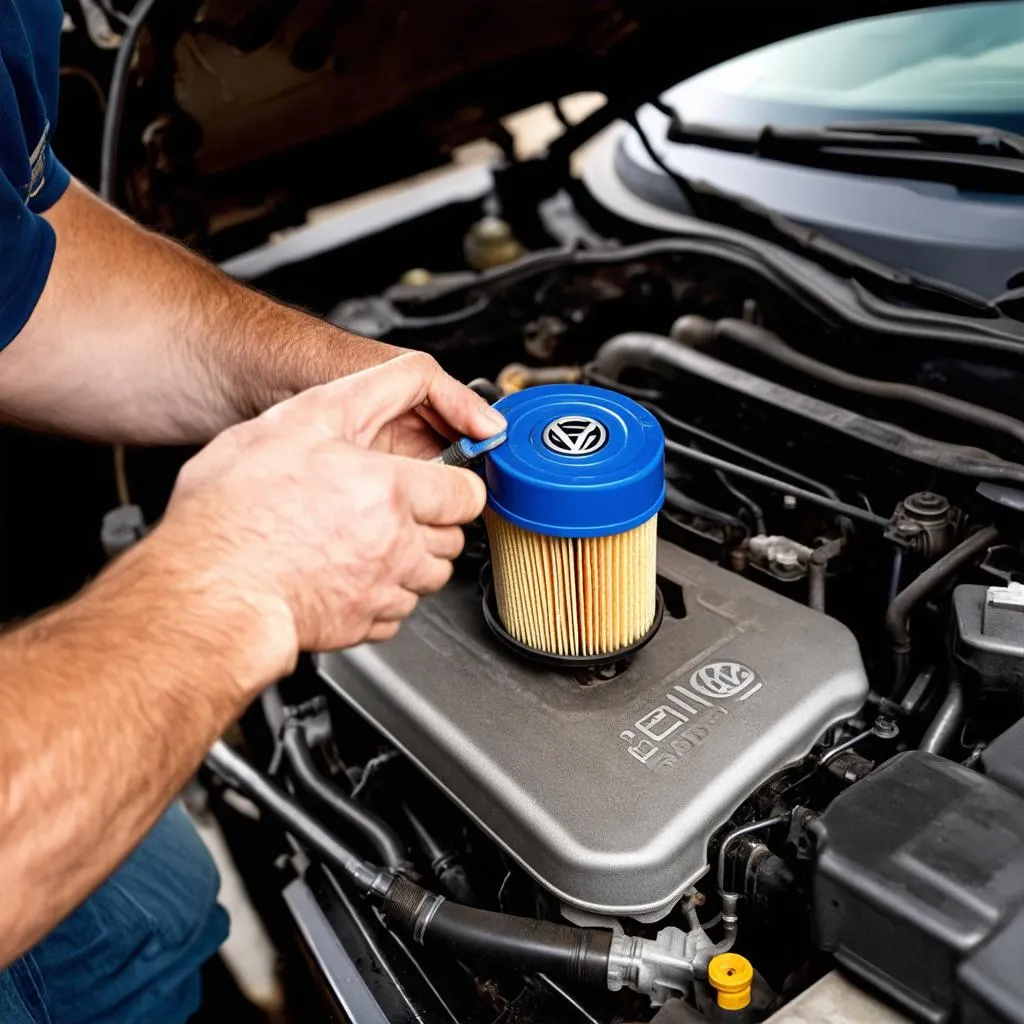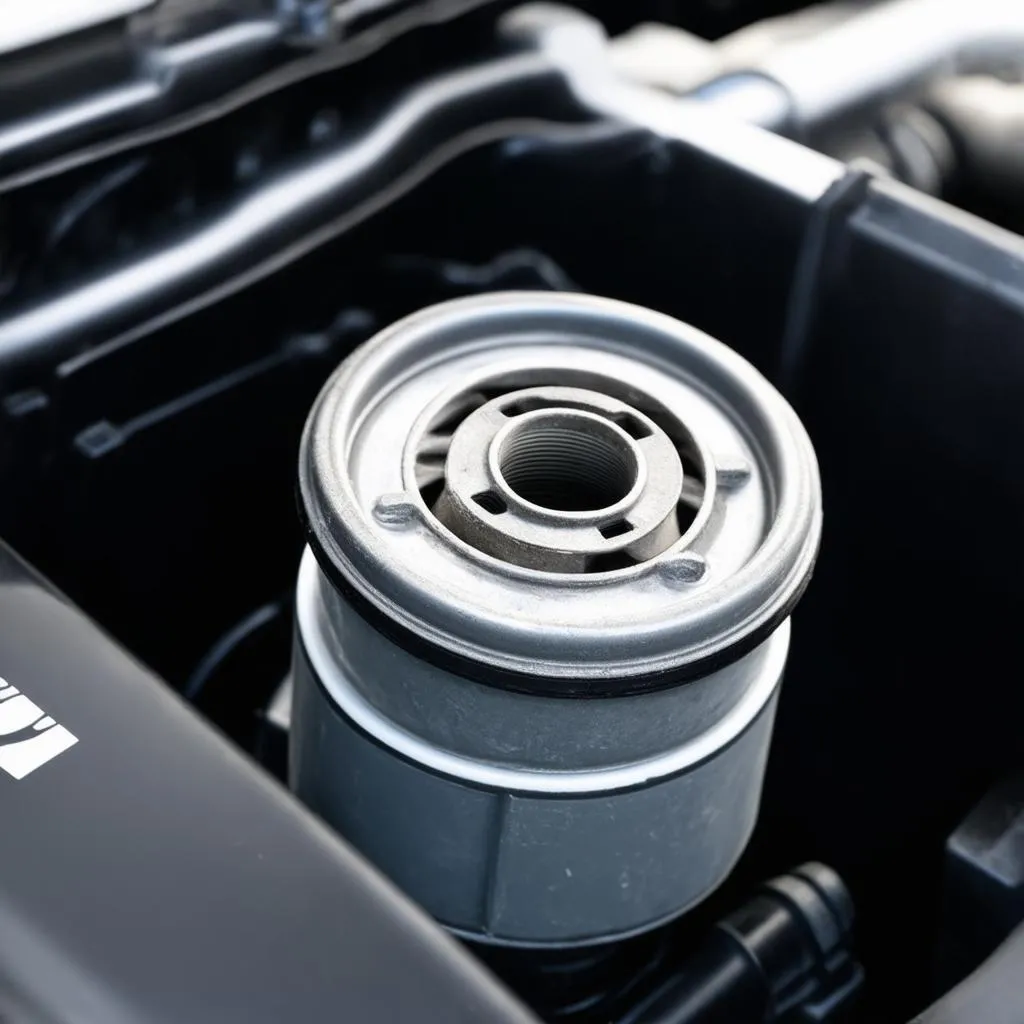VW TDI Fuel Filter Replacement with VCDS: A Comprehensive Guide
“A stitch in time saves nine.” – This old saying applies perfectly to car maintenance. Just like a stitch can prevent a tear from becoming a hole, timely servicing can prevent minor issues from escalating into costly repairs. And today, we’ll delve into one such crucial maintenance procedure: replacing the fuel filter in your VW TDI engine with the help of VCDS.
What is a VW TDI Fuel Filter and Why is it Important?
A fuel filter is a crucial component in your VW TDI engine. It acts like a guardian, protecting your engine’s delicate fuel injectors from dirt, debris, and other contaminants that may be present in the fuel.
Imagine a river flowing into a pristine lake. The river carries with it all sorts of sediment and debris, but a filter at the river’s mouth prevents this pollution from reaching the lake. Similarly, the fuel filter in your VW TDI stops harmful particles from reaching the delicate fuel injectors, ensuring smooth and efficient engine operation.
Now, let’s bring in VCDS, the powerful diagnostic tool for VW and Audi vehicles. VCDS, short for “VAG-COM Diagnostic System”, is a software interface that allows you to communicate with your car’s computer, accessing and modifying various parameters. In the context of a fuel filter replacement, VCDS plays a crucial role in resetting the fuel filter service interval, ensuring accurate readings on your dashboard.
When Should You Replace Your VW TDI Fuel Filter?
The general recommendation for replacing your VW TDI fuel filter is every 20,000 miles or two years, whichever comes first. However, the ideal replacement interval can vary depending on factors like fuel quality and driving conditions.
Think of your fuel filter as a personal bodyguard for your engine. The more harsh the environment (think dusty roads or contaminated fuel), the more frequently you need to change its protective gear.
How to Replace a VW TDI Fuel Filter with VCDS: A Step-by-Step Guide
Replacing a fuel filter on a VW TDI with VCDS is a relatively straightforward process, but it requires some technical know-how and the proper tools. Let’s outline the essential steps:
Step 1: Gather your Tools and Materials
Before embarking on this journey, ensure you have everything you need:
- VCDS cable and software: This is the crucial tool that allows you to communicate with your car’s computer and reset the service interval.
- New fuel filter: Choose a high-quality filter that meets your car’s specific requirements.
- Fuel filter wrench: This tool is needed to loosen and tighten the fuel filter housing.
- New fuel filter gasket: Ensure a tight seal and prevent leaks.
- Shop towels or rags: For cleaning spills and keeping your workspace tidy.
- Safety glasses: Protect your eyes from potential fuel or fluid spray.
- Gloves: Keep your hands clean and protected.
Step 2: Locate the Fuel Filter Housing
The fuel filter housing is typically located on the passenger side of the engine bay, under the air intake.
Imagine a hidden treasure chest guarded by a fierce dragon. The fuel filter is like that treasure chest, and you need to know where to find it and how to disarm the dragon (in this case, the fuel filter housing) to access it.
Step 3: Release the Fuel Pressure
Before disconnecting the fuel filter, it’s crucial to release the pressure built up within the fuel lines.
Think of it like deflating a tire before changing it. You need to safely release the pressure before messing with the actual component.
Step 4: Disconnect the Fuel Lines
Once the pressure is released, you can disconnect the fuel lines leading to and from the fuel filter.
Imagine a carefully constructed bridge connecting two important cities. You need to temporarily disconnect the bridge to replace its central pillar (the fuel filter).
Step 5: Remove the Fuel Filter Housing
Using the fuel filter wrench, loosen and remove the fuel filter housing.
Think of this as unlocking the treasure chest. You need the right key (the fuel filter wrench) to access the treasure inside (the fuel filter).
Step 6: Install the New Fuel Filter
Carefully insert the new fuel filter into the housing, ensuring the gasket is properly seated.
Imagine a delicate puzzle, where each piece needs to fit perfectly for the puzzle to complete. The same applies to installing the new fuel filter.
Step 7: Reconnect the Fuel Lines
Connect the fuel lines back to the new fuel filter, ensuring they are securely fastened.
Imagine reconnecting the bridge, ensuring it’s strong and stable enough to handle traffic.
Step 8: Tighten the Fuel Filter Housing
Use the fuel filter wrench to tighten the fuel filter housing until it is snug but not over-tightened.
Imagine securing the treasure chest with a sturdy lock. You need to tighten it enough to prevent it from opening accidentally but not too tight that it damages the chest.
Step 9: Reset the Fuel Filter Service Interval with VCDS
Using your VCDS cable and software, connect to your car’s computer and navigate to the “Fuel Filter Service Interval” section. Reset the interval to indicate the installation of a new fuel filter.
Imagine resetting the countdown timer on a bomb. By resetting the service interval, you’re essentially restarting the timer for your fuel filter, ensuring it gets replaced on time.
Step 10: Start the Engine and Check for Leaks
After completing the fuel filter replacement, start your engine and check for any leaks.
Imagine a carefully crafted water balloon. You need to ensure it’s leak-proof before you start throwing it around.
Troubleshooting Fuel Filter Replacement Issues:
Sometimes, even with careful execution, things can go wrong. Here are some common issues and how to troubleshoot them:
Issue 1: Engine Won’t Start
If your engine fails to start after the fuel filter replacement, there might be a problem with the fuel lines or the fuel pump. Check for any leaks or loose connections.
Imagine a broken water pipe. Water won’t flow if the pipe is broken. Similarly, fuel won’t reach the engine if the fuel lines are damaged.
Issue 2: Engine Runs Rough
If your engine runs rough or stalls after the replacement, it could be a sign of air trapped in the fuel lines. Bleeding the lines can often resolve this issue.
Imagine a clogged water pipe. Water flows sluggishly if the pipe is clogged. Similarly, fuel can be restricted if air is trapped in the lines.
Issue 3: Service Light Remains On
If the fuel filter service light remains on even after resetting the service interval with VCDS, you might need to check the connection between your VCDS cable and the vehicle.
Imagine a phone charger with a loose connection. The phone won’t charge if the connection is faulty. Similarly, VCDS might not communicate with your car’s computer if the cable connection is loose.
FAQs About VW TDI Fuel Filter Replacement with VCDS:
Can I Replace the Fuel Filter Without VCDS?
While it’s possible to replace the fuel filter without VCDS, it’s highly recommended to use it. VCDS allows you to reset the service interval, preventing the “service engine soon” light from illuminating. It also helps diagnose any issues that may arise during the process.
Think of VCDS as a reliable guide. It helps you navigate the process safely and efficiently, ensuring your engine stays healthy.
What Happens If I Don’t Replace the Fuel Filter On Time?
Ignoring fuel filter maintenance can lead to various issues, including reduced fuel economy, decreased engine performance, and even engine damage.
Imagine a clogged water filter in your home. Dirty water won’t flow freely. Similarly, contaminated fuel can lead to poor engine performance.
How Often Should I Replace the Fuel Filter?
As a general rule, VW TDI fuel filters should be replaced every 20,000 miles or two years, whichever comes first. However, this can vary based on driving conditions and fuel quality.
Think of your fuel filter as a personal bodyguard for your engine. The more harsh the environment, the more frequently you need to change its protective gear.
Alternative Fuel Filter Replacement Options for VW TDI:
While VCDS is the most popular option for resetting the fuel filter service interval, other methods exist.
Option 1: Using a Diagnostic Tool
Many diagnostic tools on the market can communicate with your car’s computer and reset the service interval.
Imagine different types of phones. They all serve the same purpose, but each has its unique features. Similarly, different diagnostic tools can achieve the same goal, but each may offer different functionalities.
Option 2: Using a Generic OBD2 Scanner
In some cases, a generic OBD2 scanner may be able to reset the service interval. However, this is not guaranteed, and its functionality may be limited.
Imagine a universal key. It can unlock various doors, but it may not work for every lock. Similarly, a generic OBD2 scanner may work for some cars, but not all.
Option 3: Using a Manual Reset Method
Some manufacturers offer manual reset methods that involve specific button combinations on the dashboard. However, these methods are not always straightforward and may vary depending on your car model.
Imagine a hidden code. It unlocks a specific feature, but you need to know the code to use it. Similarly, manual reset methods require specific steps that may not be readily available.
Other Relevant Articles:
Conclusion:
Maintaining your VW TDI fuel filter is crucial for ensuring smooth and efficient engine operation. While replacing the fuel filter can be a straightforward process, using VCDS is highly recommended to reset the service interval and ensure accurate readings on your dashboard.
Remember, like any intricate machine, your car thrives on regular maintenance. Taking the time to perform routine services like fuel filter replacement can save you from potential headaches down the line.
If you have any questions about fuel filter replacement, or need help with VCDS or any other diagnostic tool, feel free to reach out to us.
Contact us on Whatsapp: +84767531508
 Fuel Filter Replacement
Fuel Filter Replacement
 VCDS Cable
VCDS Cable
 Fuel Filter
Fuel Filter
